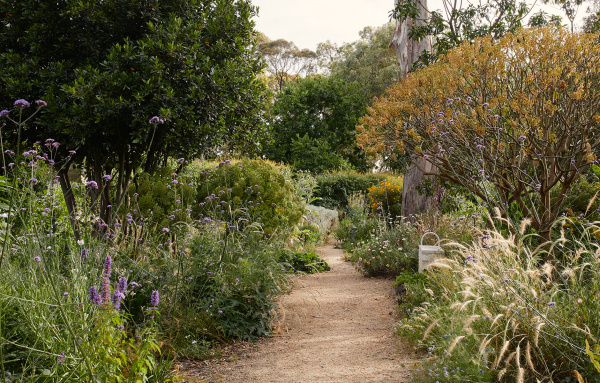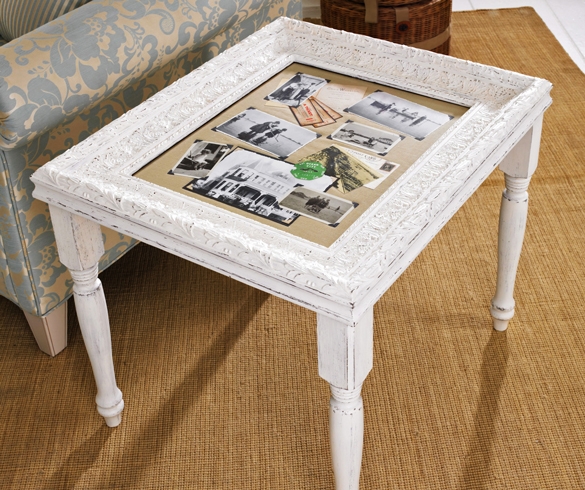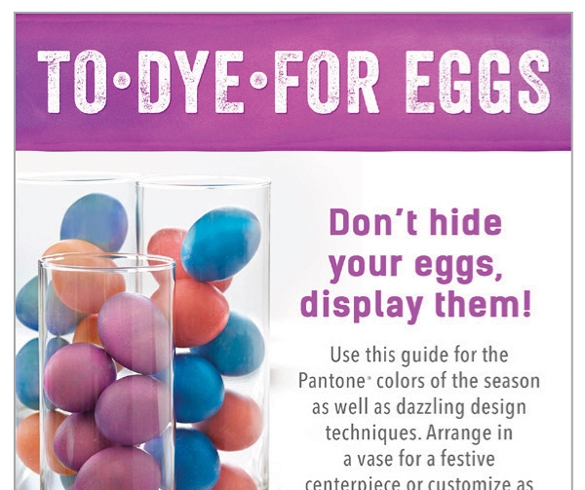Heide Museum of Modern Art’s new healing garden is positioned on the site of co-founder Sunday Reed’s first kitchen garden. Originally a French-style potager, with raised gardens beds of vegetables and herbs to feed the Reeds and the famous artists they invited to Heide, this kitchen garden was eventually moved to its current location due to eucalyptus trees casting too much shadow over the space.
Sunday’s friend Barrett Reid later attempted to plant a “rainforest” garden (possibly out of nostalgia for Queensland, where he was from) on the original site, although these plantings were largely unsuccessful and strayed from the initial vision. Over time, the garden became under-utilised and overgrown.
The idea for a healing garden to revitalise the space was proposed several years ago by Heide gardener and former nurse, Katie Grace. Bringing her two professions together, Katie wrote a compassionate and thoughtful brief for a garden that offered therapeutic benefits for the mind, the soul and the body.
Longtime Heide collaborators Openwork were engaged to design the garden, incorporating existing planting within a textural field of new flowering exotics and natives. ‘The garden space was envisaged to be enchanting, playful, reflective, restorative, restful and offer quietude,’ says registered landscape architect Liz Herbert from Openwork.
The new design retains the original heritage paths, but encourages a deliberately different experience, creating a place that invites one to stay, dwell and be immersed.
‘The garden aligns with the philosophies of Sunday Reed as a place of wellbeing, produce, experimentation, and sensory indulgence. It is a biophilic hug, inviting carers and individuals of all ages living with physical, cognitive, psychological, or behavioural challenges to occupy the garden in solitude or through programmed activities.’
The formation of six different planting clusters facilitates a variety of sensory activities. Scented Entries marks the entry (a living posy of plants that emit strong, year-round fragrance, including Sunday Reed’s original roses); followed by Sensory Kitchen Garden (including plants with edible leaves or flowers); Haptic Play Garden (celebrating textural plants and water play); Bush Garden (which builds on Heide’s current collection of Indigenous edible plants); The Meadow (the largest of the planted clusters that draws on the style of herbaceous gardens pioneered by British horticulturist Gertrude Jekyll, who was an influence on the Reeds); and the Wild Garden (inspired by rambunctious climbing roses that characterise the Heide Cottage wall).
Small garden seats made using leftover limestone blocks from Heide Modern are placed throughout, encouraging users to dwell and be mindful in the space. ‘I think the use of leftover limestone blocks from the Heide Modern building as seats is aesthetic genius, as well as eminently practical so that people can linger in the garden as long as they wish and feel enveloped in the space, viewing and interacting with the garden at its best vantage points,’ says Lesley Harding, artistic director at Heide.
Heide’s healing garden took around three years from concept to realisation to complete, and was made possible by the generous support of the Shine On Foundation, a number of private donors who attended Heide’s Women’s lunch in 2019, and Eco Outdoor who supplied the paving elements. Liz in particular has lived and breathed this garden, coming into Heide almost weekly whenever COVID restrictions allowed, clearing, planting and refining its every aspect.
‘While it looks rambling and inviting, the garden has been incredibly carefully thought through and is very purposeful, so that there is always something new to see and smell or touch, with different shapes and colours, fragrances and textures,’ says Lesley.
The healing garden is for everyone who visits Heide, but is purpose-designed for those who can benefit most. Together with offering workshops by naturopaths and herbal medicine experts, the museum plans to partner with community groups to co-design programs in this garden, including disability service providers and aged-care facilities.
‘There may even be meditation and yoga classes – we have lots of ideas about how we can enrich the experience of the garden,’ says Lesley. ‘I hope the healing garden becomes a place that visitors return to time and again, in all seasons and conditions.’
Heide’s Healing Garden is open every day and is free to access.
heide.com.au

The Heide Healing Garden sets out to unite a concentration of horticultural and constructed elements that promote therapy and healing; food production; and an immersive ground for art, and play. Photo – Amelia Stanwix for The Design Files.

The garden space was envisaged ‘to be enchanting, playful, reflective, restorative, restful and offer quietude. Photo – Amelia Stanwix for The Design Files.

The idea for a healing garden to revitalise the space was proposed several years ago by Heide gardener and former nurse, Katie Grace. Photo – Amelia Stanwix for The Design Files.

Bringing her two professions together, Katie wrote a compassionate and thoughtful brief for a garden that offered therapeutic benefits for the mind, the soul and the body. Photo – Amelia Stanwix for The Design Files.

Longtime Heide collaborators Openwork were engaged to design the garden, incorporating existing planting within a textural field of new flowering exotics and natives. Photo – Amelia Stanwix for The Design Files.

Unlike the original kitchen garden paths that were arranged in linear rows for efficient production, the new layout is deliberately opposite – a place that invites one to stay, dwell and be immersed. Photo – Amelia Stanwix for The Design Files.

Healing garden is positioned on co-founder Sunday Reed’s first kitchen garden, which was moved due to the eucalyptus trees casting shadows. Photo – Amelia Stanwix for The Design Files.

The garden aligns with the philosophies of Sunday Reed as a place of wellbeing, produce, experimentation, and sensory indulgence. Photo – Amelia Stanwix for The Design Files.

The healing garden is for everyone who visits Heide, but is purpose-designed for those who can benefit most. Photo – Amelia Stanwix for The Design Files.

The creation of six different planting clusters facilitates a variety of sensory activities. Photo – Amelia Stanwix for The Design Files.

‘While it looks rambling and inviting, the garden has been incredibly carefully thought through and is very purposeful, so that there is always something new to see and smell or touch, with different shapes and colours, fragrances and textures,’ says Lesley. Photo – Amelia Stanwix for The Design Files.

The Sensory Kitchen Garden section includes plants with edible leaves or flowers. Photo – Amelia Stanwix for The Design Files.

Small garden seats made using leftover limestone blocks from Heide Modern are placed throughout, encouraging users to dwell and be mindful in the space. Photo – Amelia Stanwix for The Design Files.

‘I think the use of leftover limestone blocks from the Heide Modern building as seats is aesthetic genius, as well as eminently practical so that people can linger in the garden as long as they wish and feel enveloped in the space, viewing and interacting with the garden at its best vantage points,’ says Lesley Harding, artistic director at Heide. Photo – Amelia Stanwix for The Design Files.

The healing garden took around three years from concept to realisation to complete, Photo – Amelia Stanwix for The Design Files.








